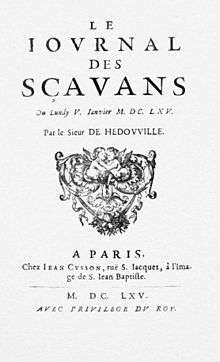Journal des sçavans
The Journal des sçavans (later renamed Journal des savans and then Journal des savants), established by Denis de Sallo, was the earliest academic journal published in Europe. Its content included obituaries of famous men, church history, and legal reports.[1] The first issue appeared as a twelve-page quarto pamphlet[2] on Monday, 5 January 1665.[3] This was shortly before the first appearance of the Philosophical Transactions of the Royal Society, on 6 March 1665.[4] The 18th-century French physician and encyclopédiste Louis-Anne La Virotte (1725–1759) was introduced to the journal through the protection of chancellor Henri François d'Aguesseau.
 | |
| Language | French |
|---|---|
| Publication details | |
| History | 1665–1792, 1797, 1816–present |
| Frequency | Annual |
| Standard abbreviations | |
| ISO 4 | J. Sçavans |
| Indexing | |
| ISSN | 1775-383X |
| Links | |
The journal ceased publication in 1792, during the French Revolution, and, although it very briefly reappeared in 1797 under the updated title Journal des savants, it did not re-commence regular publication until 1816. From then on, the Journal des savants was published under the patronage of the Institut de France. From 1908, it was published under the patronage of the Académie des Inscriptions et Belles-Lettres. It continues to be a leading academic journal in the humanities.
Landmark articles
Ole Rømer's determination of the speed of light was published in the journal, which established that light did not propagate instantly. It came to about 26% slower than the actual value.
- Rømer, O (1676). "Démonstration touchant le mouvement de la lumière trouvé par M. Römer de l'Academie Royale des Sciences" (PDF). Journal des sçavans (in French): 223–36. Translated as "A Demonstration concerning the Motion of Light". Philosophical Transactions of the Royal Society. 12 (136): 893–94. 1677. Bibcode:1677RSPT...12..893.. doi:10.1098/rstl.1677.0024. Archived from the original on 2007-07-29.
References
- The Amsterdam printing of the Journal des sçavans, Dibner Library of the Smithsonian Institution
- Brown, 1972, p. 368
- Hallam, 1842, p. 406.
- Partridge, Linda (March 6, 2015). "Celebrating 350 years of Philosophical Transactions: life sciences papers". Philosophical Transactions of the Royal Society B: Biological Sciences. The Royal Society. 370 (1666): 1. doi:10.1098/rstb.2014.0380. PMC 4360128. PMID 25750243.
Further reading
- Brown, Harcourt (1972). "History and the Learned Journal". Journal of the History of Ideas. 33 (3): 365–378. doi:10.2307/2709041. JSTOR 2709041.
- Hallam, Henry (1842). Introduction to the Literature of Europe in the Fifteenth, Sixteenth, and Seventeenth Centuries. Harper & Brothers.
- James, Ioan (2004). Remarkable Physicists: From Galileo to Yukawa. Cambridge University Press. ISBN 0-521-01706-8.
- Kilgour, Frederick G. (1998). The Evolution of the Book. Oxford University Press. ISBN 0-19-511859-6.
External links
| Wikimedia Commons has media related to Journal des sçavans. |